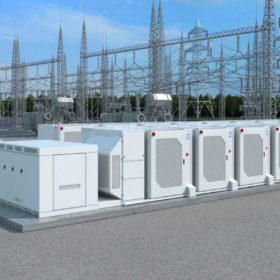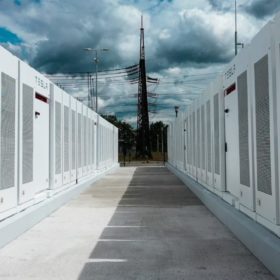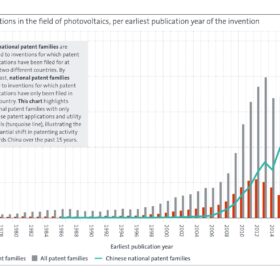Top News
India needs to invest $1.5 trillion by 2030 for climate action at scale: Deloitte report

Tata Power Renewable Energy secures 120 MWh battery energy storage purchase agreement with NHPC

New solar trade cases focus on Asian countries
pv magazine Webinar
pv magazine Webinar

ACME Solar secures 275 MW/550 MWh battery energy storage purchase agreements with NHPC

Photovoltaic inventions increased seventeen-fold in three decades
Sterling and Wilson Renewable Energy Q1 revenue rises 93% YoY to INR 1,762 crore
Waaree Renewable Technologies Q1 profit surges 206.77% YoY to INR 86.39 crore
RenewSys to ramp up encapsulant capacity to 30 GW
Markets & Policy
Featured
The Hydrogen Stream: Hygenco commissions green hydrogen plant to decarbonize Sterlite Technologies’ optic fibre production
Distributed solar poised to shape the next decade of India’s energy transition through residential, C&I rooftops, and hybrid microgrids
India has set an ambitious target of 280 GW of solar capacity by 2030, and of this, at least 40-45 GW is expected to come from distributed solar — a conservative estimate, considering the pace at which the ecosystem is maturing.
Oriana Power enters MoU to explore and develop renewable energy projects in Canada’s Alberta province
Oriana Power has entered a Memorandum of Understanding with Invest Alberta Corp. (IAC), to explore and develop renewable energy projects in Canada’s Alberta province.
One Big Beautiful Bill is anti-solar: US industry reacts
The budget bill and a Trump executive order are expected to have a damaging effect to the solar industry, but strong fundamentals like increased demand and lowered component costs are expected to drive installations forward.
Reliance Power to raise INR 9,000 crore via QIP, FPO and NCDs
Reliance Power has approved plans to raise up to INR 6,000 crore via a Qualified Institutions Placement (QIP), follow-on public offer (FPO), or a combination of both. The company also plans to raise up to INR 3,000 crore through the issuance of non-convertible debentures (NCDs).
Mufin Green Finance raises $6.5 million from Developing World Markets to accelerate EV and clean energy financing in India
The funds will mainly be used for EV loans and leases, while also financing EV batteries, charging infrastructure, and solar panel installations for residential and commercial & industrial (C&I) projects.
Installations
Featured
Zelestra India scales C&I portfolio to 122+ MW with solar-wind-BESS hybrid solutions
Enlight Metals enters solar structure aggregation
Enlight Metals plans to aggregate and supply solar mounting structures sourced from multiple manufacturers across Maharashtra, with an initial focus on the Pune market.
Photovoltaics for cargo ships
Wattlab has installed a PV system capable of delivering up to 35 kW to a cargo ship’s high-voltage propulsion system, allowing it to temporarily replace one of four diesel generators under optimal conditions.
GameChange Solar trackers deployed in India’s first project featuring First Solar’s Series 7 thin film PV modules
GameChange Solar’s Genius Tracker system has been deployed in India’s first project featuring First Solar’s Series 7 thin film PV modules. The project, developed by Cleantech Solar and constructed by Jakson Green, has a total planned capacity of 44.8 MWp.
Rotomag invests in Su-vastika
The strategic collaboration with Rotomag will equip Su-vastika with deep industrial expertise and robust manufacturing capabilities as it aims to scale clean, intelligent, and scalable energy solutions across India and global markets.
NHPC allocates 1.2 GW of solar-plus-battery storage at INR 3.13/kWh
Reliance Infrastructure secured the largest slice of 390 MW. Other winners include PNC Infratech and SAEL Industries (300 MW each), JBM Renewables (150 MW) and Navayuga Engineering (60 MW).
Technology
Featured
Li-S achieves Australian first with lithium metal foils
Meeting evening peaks with clean power requires a three-pronged strategy: IEEFA
The persistent evening peaks, which now nearly match daytime highs, reinforce the urgency of deploying storage solutions, demand-side measures and hybrid renewable projects to meet post-sunset demand.
Upcycling solar glass waste to use in solid-state lithium batteries
Nanyang Technological University researchers have milled solar panel glass waste for use in cathodes used in solid state lithium metal batteries. When used as a functional filler in solid polymer electrolyte (SPE) material, the resulting battery performance was maintained over 80 charge cycles with an 8.3 % improvement over the reference device.
Four-year outdoor testing shows perovskite cells suffer from high seasonality
Testing conducted by the Helmholtz-Zentrum Berlin in Germany has shown that perovskite solar cells operating at high latitudes in Europe may suffer from higher performance losses in winter compared to conventional PV devices. The scientists warned, however, that at lower latitudes this seasonality may be less pronounced.
The Hydrogen Stream: IIT Madras, Hyundai to launch green hydrogen innovation centre
Hyundai Motor India Ltd (HMIL), in collaboration with IIT Madras, will establish a 65,000 sq. ft. green hydrogen innovation centre in Chennai, enabling research, development, and deployment of hydrogen technologies.
“India on track to achieve 50% renewable energy milestone by year-end”: Union power minister
“India is on track to achieve the milestone of 50% renewable energy share in its total installed power generation capacity by the end of the year,” said union power minister Manohar Lal Khattar at the 11th edition of India Energy Storage Week (IESW) 2025.
Manufacturing
Featured
Sinovoltaics maps 68.4 GW of solar module capacity in India
Tongwei, Longi, JA Solar announce H1 losses
Tongwei, Longi, and JA Solar have predicted steep losses for the first half of 2025, as persistent oversupply and falling solar module prices continue to pressure margins across China’s PV manufacturing sector.
US launches national security probe into polysilicon imports
The US Department of Commerce (DoC) says it will investigate the potential for export restrictions by foreign countries, as well as their ability to “weaponize” their control over supplies of polysilicon.
Alpex Solar secures 300 MW PV cell deal with TP Solar
Alpex Solar Ltd has approved a definitive procurement agreement with TP Solar Ltd for supply of solar cells with a minimum aggregate capacity of 300 MW.
SAEL to set up 5 GW solar cell and module manufacturing facility in Uttar Pradesh
SAEL Industries Ltd will invest around INR 8,200 crore to establish a 5 GW integrated solar cell and module manufacturing facility in Greater Noida, Uttar Pradesh. Once operational, it will take SAEL’s total solar manufacturing capacity to 8.5 GW.
Huawei leads global inverter market as shipments hit 589 GW in 2024
Chinese companies made up nine of the 10 largest global inverter suppliers in 2024, with total inverter shipments reaching 589 GW (AC), according to Wood Mackenzie.
Energy Storage
Featured
Ola Electric targets full 5 GWh battery cell capacity by the end of FY2026
“Energy storage will account for half our business within three years”: Geon vice president
Khushi Kabra, Vice President–Strategy at Geon (formerly Battrixx), speaks to pv magazine on pivoting from electric vehicle (EV) batteries to building a strong foothold in the energy storage space.
Australia’s green hydrogen plan faces water shortage
Green hydrogen is touted by some as the future – a way for Australia to slowly replace its reliance on fossil fuel exports. The energy-dense gas has the potential to reduce emissions in sectors challenging to decarbonise, such as steelmaking and fertiliser manufacturing.
Tata Power inaugurates green energy skilling centre in Delhi
Tata Power’s Green Energy Skill Centre will impart training in renewable energy technologies, including solar PV system installation, commissioning and operation and maintenance, energy storage, pumped hydro storage, and electrical safety to prepare future-ready green energy workforce for the country’s energy transition.
India’s emerging role in EV battery recycling: Creating a circular economy
India is well-placed to advance the e-mobility circular economy in Asia against the backdrop of the fast-growing market and recycling strategies. Adopting the 5Rs—Reduce, Reuse, Repurpose, Remanufacture, and Recycle—can help in reducing resource depletion and waste.
Australian Clean Energy delegation visits India to further deepen their engagements
A 30-member Australian Clean Energy Delegation representing 22 companies, is visiting India from July 7 – 11, 2025 to showcase Australia’s innovative solutions across energy storage technologies, AI solutions for energy operations, solar technologies, green hydrogen, energy modelling and weather forecasting, education & capacity building and consulting.
Opinion & Analysis
Featured
How homeowners in Tier 2 cities are switching to solar
China polysilicon price increases amid regulatory signals
In a new weekly update for pv magazine, OPIS, a Dow Jones company, provides a quick look at the main price trends in the global PV industry.
What standards for agrivoltaics?
The technology which combines solar PV panels and agriculture is gaining ground. IEC Standards for solar photovoltaic (PV) systems already exist, but more might be required, dealing with some of the more specific issues relating to agriculture.
How is India’s power infrastructure evolving amid global supply chain shifts?
With renewable capacity expanding, grid upgrades underway, and policies fostering local supply chains, India is navigating a complex but promising energy transition.
Powering a greener future through India’s clean energy transition
As India adds more intermittent renewables like solar and wind to its energy mix, modernising the electricity grid becomes a priority. Grid expansion, integration of battery storage systems, and digital monitoring tools are critical to accommodate fluctuations in generation and demand.
Bringing back-contact to the foreground
Solar manufacturers are pursuing the next-generation crystalline silicon (c-Si) PV cell technology. Back-contact (xBC) technologies including TOPCon back-contact (TBC), HJT back-contact (HBC), and HJT TOPCon back-contact (HTBC) have emerged as leading candidates, attracting attention for their superior conversion efficiency and aesthetic module designs.



